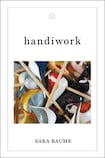
There is a line in Sara Baume’s last book, A Line Made by Walking, which embedded itself so deeply in me I knew I’d read every single thing she ever wrote: “I’ll make a home in my routine. And this will be enough for me.”
Her new book, published by the increasingly excellent Tramp Press – her first non-fiction – could be compared with Denise Riley’s Time Lived, Without Its Flow in how beautifully rendered the passing of days is – or with Maggie Nelson’s Bluets, in how delicately the poetry of the work is presented on the page.
In truth, though, this small work is a thing utterly of its own shape; gifted to us by a writer using her own self to form this paper object; as a bird sculpts her nest through rhythmical, circular movements, the individual act of making.
There is making in this book, birds too; there is, in fact, the making of birds: “I expected to be relieved, once it was all made. This flock that I began after my dad died . . . Instead I am outstandingly lonely.”
Images of this grief-moulded flock are interspersed throughout the text – visual representations of the rawness of her loss, the honesty of her writing; the dedication to her daily craft. Other makers are paid tribute to, also: her own father; his father – this is a testimony to those that came before Baume; her own kinfolk nestle in beside the likes of William Morris.
There is so much doing in this book – unsung, household activities, actions of the ordinary, are repeated and reported, making a dance of the everyday art of being alive. Alongside making dinner, dressing and cleaning up, we watch the author making ready to create; her wings priming themselves for their daily rhythm – their journey through the unknown winds in rare, and soaring “flow” – when it comes.
Making, ordering and assembling in the “house of industry” she and her partner inhabit are painted splendidly: there is “sandpaper of varying grits – from coarse to fine and from unfolded to extensively folded”. Oh! the glistening minutiae Baume unearths.
Making is sometimes a solitary, utterly devastating thing, though, and we see 100 discarded objects, 100 lost days; “an entire winter”. What does she do? She starts again, of course; making objects “alone and utterly. A trail of progress I can . . . move around in a shaft of light; I can hold aloft to the damaged planet”.
The closeness between Baume and her equally creative partner is chronicled in an incredibly moving manner; members of the same flock, sharing the same sky. “I take up a little more space”, though, she tells us, and I take heart at this line – here we see the ways in which creating, placing things into this world – can start to redress an age-old imbalance of power. There is strength in this telling of a life, that is outwith the supposed borderlines of gender.
Belonging
They replace a feeder in their garden, and patiently wait for birds: “The birds I want to see . . . are the ones which live . . . in the places where I live.” Very few come, though, so Baume visits an island to find them. Homes, nests, belonging, identity and resilience; this book is an ode to spaces that are safe. The Earth is in a heart-wrenchingly fragile state, and Baume’s gaze illuminates our role in it all; attention and care – real care – could be our hope.
The writing is measured and gorgeous, full of “poetic coincidences”, with a rooted awareness of self that is both free from pity and steeped in clarity. When her dad died, the swallows he knew swooped and looped, in amongst the objects he had brought into the world; birds finding sanctuary – real refuge. Her mother photographed his creations: “See the things and places in which he still lives.” Objects as ghost-traces; full of light. This is a bodily book, too: “The sickles of . . . paint . . . from . . . my fingernails mirror the row of brilliant white crescents along the living room wall – as if I am the house, or the house is me.”
This is a book touched by loss but it is also a book touched by life; by flight; this is a book about light. In The Grassling – a book just as difficult to define as this one, also about the earth, creating, living and dying – Elizabeth-Jane Burnett writes of finding new ways, outside of words, to travel to her dying father: “Everywhere: sun. Even on a cold March day. Everywhere: light.” As I leave handiwork on this cold March day, everywhere is light.
Thin Places by Kerri Ní Dochartaigh will be published next spring by Canongate











